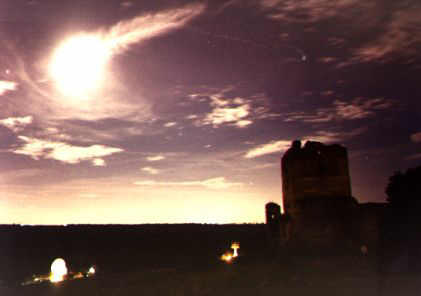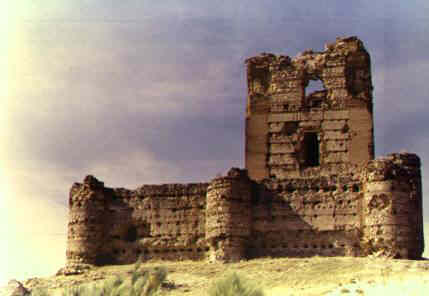


During the weekend from 2 to 4 of Ocober 1998, we are going to camp near the Villafranca del Castillo castle and we will transmit from there. The activation is part of the "Castillos de España" diploma. The reference is CM-007.
The castle is in Villanueva de la Cañada, about 35 Km. from Madrid. It is very near the ESA Satellite Tracking Station. Due to this proximity we will (maybe) restrict the power and operating modes. Likely we will have to forget to work the VHF band.
Our equipment will consist of two or three HF tranceivers, some wire dipoles, long wires for 160 and 80 meters and a 5/8 vertical antenna for the 10 meters band. We will use the special call ED4RAX.
by Jon Darius
 The earliest reference to our castle, aside from the
property title itself, is buried in the typically prolix will of Don Alfonso, witnessed in
Madrit (Madrid) in 1450, where he counts among his considerable possessions "the site
of Villafranca with its fortress and boundaries and civil and criminal jurisdiction and
court ruling [an approximate rendering of 'mero mixto imperio'] and with all its property
and all its arms and supplies and provisions ['... pertrechos y abastecimiento'] which are
and were in the said place and in its fortress, and with all that has been erected and
extended in the said place and fortress". From the mid-fifteenth to the early
eighteenth century we have no information on the evolution of the site or its fortress,
but by 1813 the will of the Marquis of Gelo and Villamagna refers to Villafranca del
Castillo as "despoblado" (despoiled, depopulated). The 1844 "hijuela"
of the Marquis of Sotomayor (an hijuela is a schedule given to an heir defining his share
in the estate) says that Villafranca del Castillo consisted of a small village
("caserío") -- presumably not the prior one on our site, vineyards, chaparral
(= plantation of the evergreen oaks called "encinas"), and sowed fields --
altogether valued at 1,329,850 reales (the real was a silver coin). 15 years later (during
the reign of Isabel II, as yet undeposed), the property had accrued in value by 30%; by 50
years later (Alfonso XII's reign it had more than doubled. (1 peseta = 4 reales.)
The earliest reference to our castle, aside from the
property title itself, is buried in the typically prolix will of Don Alfonso, witnessed in
Madrit (Madrid) in 1450, where he counts among his considerable possessions "the site
of Villafranca with its fortress and boundaries and civil and criminal jurisdiction and
court ruling [an approximate rendering of 'mero mixto imperio'] and with all its property
and all its arms and supplies and provisions ['... pertrechos y abastecimiento'] which are
and were in the said place and in its fortress, and with all that has been erected and
extended in the said place and fortress". From the mid-fifteenth to the early
eighteenth century we have no information on the evolution of the site or its fortress,
but by 1813 the will of the Marquis of Gelo and Villamagna refers to Villafranca del
Castillo as "despoblado" (despoiled, depopulated). The 1844 "hijuela"
of the Marquis of Sotomayor (an hijuela is a schedule given to an heir defining his share
in the estate) says that Villafranca del Castillo consisted of a small village
("caserío") -- presumably not the prior one on our site, vineyards, chaparral
(= plantation of the evergreen oaks called "encinas"), and sowed fields --
altogether valued at 1,329,850 reales (the real was a silver coin). 15 years later (during
the reign of Isabel II, as yet undeposed), the property had accrued in value by 30%; by 50
years later (Alfonso XII's reign it had more than doubled. (1 peseta = 4 reales.)
All the deeds of sale from 1880, when the property passed to His Excellency Don Fernando Puig y Gibert, until 1918, when it was bought by the Ballesteros family who still own it, mention that the castle which now overlooks the Station served as the dwelling of a guard or keeper. ("Habitación de un guarda" is not properly a "guardhouse" since for at least a century there had been no hamlet to guard.) Aside from some stables and sheds, these deeds also note the existence of fields or grain and pulses, evergreen oaks stands, and poplar or elm groves ripe for exploitation. Actually, trees in the Station environs have been decimated more effectively by fire and disease than by commercial interests.
The Castle of Villafranca became once again a true fortress during the Civil War, for the very region where the tracking station now stands saw some of the bitterest fighting of the war: the battle of Brunete in July 1937, in which Republican forces attempted to stave off the Nationalist advance on Madrid. Initially a brigade of Soviet soldiers enlisted for the cause of the Rojos (Republicans) were garrisoned in the Castle, sleeping on the ground in rough blankets. Nationalist troops launched a successful assault after shelling the medieval structure, theretofore quite well preserved. Whether it is a comment on his personal sympathies or on constraints under the prevailing regime is not clear, but F. Bordejé writing about the Castle in 1974 roundly condemned the barbarians responsible for its damage: not the Nationalist bombardiers but the Rojo supporters whose occupation of the Castle made its "liberation" necessary! In any case, when the firm Agromán were contracted to construct the present Station, their first task was to trace any unexploded bombs in the vicinity.
The prior history of the Castle is wholly, apocryphal. It seems a pity to throw cold water on such romantic myths as the notion that it was the birthplace of Redbeard, the swashbuckling pirate of Algiers, or that Philip II (reign: 1556-1598) used to sneak hither to visit his one-eyed consort the Princess of Éboli. What little is known of the Castle's history draws upon the Historico-Geographic Reports prepared on the order of Philip II. In his essay in the Corpus de Castillos Medievales de Castilla, published in 1974 under the auspices of the Asociación Española de Amigos de los Castillos, F. Bordejé identifies the Castle of Villafranca with the Castle of Almenara mentioned in the Reports, a quarter of a league from La Despernada (leterally "weary woman"), apparently an old name for Villanueva de la Cañada.
While this identification may well be correct, it does not tally on any point with the property deeds (cf. supra), which unfortunately lapse between 1450 and 1799. But surely they would be expected at the very least to corroborate the name Almenara or to mention the Princesa de Éboli; they do not. With six Almenar's or Almenara's already extant among Spanish castles, some misapprehension may perhaps have arisen; the name also graces a minor peak farther west beyond Fresnedillas. Moreover, the Castle is allegedly situated on a high hill of the Sierra de Jarama -- not Guadarrama -- whose corresponding river lies east of Madrid. The Redbeard legend is said to have originated in his capture of a presumed countryman, a native of Valdelaguna, once again southeast of Madrid not far from Chinchón, which also has a ruined castle nearby. Could the two have been confused perhaps? if so, our negligible knowledge of the Castle's history becomes even more nugatory.
Additional fuel for the sceptic's fire is furnished by the Reports, in that despite a superficial resemblance between Almenara and a historically extrapolated Villafranca their sizes are incommensurate. Even allowing for the demolition wrought over four centuries, can there really have been a ravelin with sixteen towers, seven interior doors opening onto the courtyard, and stabling accommodation for a hundred horses?
The structure of the Castle, on a rectangular plan with an outsize keep in one corner, labels it one of the castles constructed under the Trastamara dynasty of the 14th and 15th centuries -- a widespread net of military Castles, in fact, demarcating the Christian north from the Muslim south during the slow process of the Reconquest. Villafranca belongs to the second network of fortifications, a line south of the Duero along with Salamanca and Segovia, the first line farther north dating back four centuries earlier. Confirmation of its age is supplied by the similarly constructed castle at Buitrago de Lozoya and by the nearly identical brick-and-stone facing of the castle at Alcalá de Henares: a typically mudéjar pattern, alternating double bands of bricks and treble bands of ashlar (square-hewn stone). the geographically nearest castle to Villafranca, the 16th century Villaviciosa de Odón, affords a complete stylistic contrast. Between the medieval style (Juan II) of the one and the Renaissance style (Charles I) of the other fell the nadir of Spanish castle history, when Isabel pillaged many of them in the process of dismantling the apparatus of feudalism.
Its strategic position on an abutment overlooking the Aulencia and Guadarrama river valleys and its crude construction shorn of artistic features emphasise that Villafranca was conceived as a purely military castle. Certainly the Princess of Éboli would not have felt at home here. The keep ("torre del homenaje") was once girdled by two protective stone walls, of which the outer has been reduced to a vestigial northern barrier. On this relatively insecure flank one can also discern traces of a moat now largely filled with sandy soil.
The inner wall, 25 metres square, has survived erosive and Nationalist ravages rather better, with round turrets ("torreones") at the corners and midpoints. Two of the turrets are hollow two-floor constructions topped by hemispherical bricks domes in the mudéjar style. The keep itself bears evidence of four floors, the last of which is evidently a later addition -- witness the different colouration and chamfered corners from base to summit. Note that these corners, or arrises, are built in brick devoid of stone. The summit must once have borne "almenas" (battlements), but now only an iron weathervane.
The inner clings to two adjoining sides of the inner wall without actually being flush with it, presumably so that its flat tops ("adarves") could serve as a sentry walk. The main entrance to the castle opens onto a courtyard, not directly into the keep, and although now disfigured this doorway is topped with a rare decorative feature: three consoles of projecting masonry which must once have supported dormer windows or perhaps a machicolated gallery. A back door, or postern, is set clandestinely into the central turret on the opposite western facade. In the absence of any means of access to the upper storeys, the only "rooms" readily visible are two oblong, brick-domed chambers presumably used for storing provisions or arms.
Since 1949 a government edict protects the 2000 castles, in whatever state of preservation, still extant in Spain. Passive conservation has turned active in some areas, but sadly not Villafranca. Perhaps the inadvertent blaze of publicity fanned by its proximity to the tracking station will eventually put an end to its neglect.
![]() webmaster:jacevedo@alum.uax.es
webmaster:jacevedo@alum.uax.es